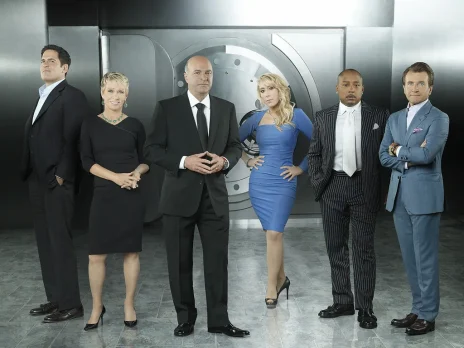
Shark Tank Cast Members
Highlights
- Shark Tank has kept updating itself with the growing trends and interests of its audience.
- The difference in investment sought for Daisy Cakes and Project Pollo is massive.
- Recently, there has been an enormous rise in the number of pitches brought to the show.
The journey of a reality show from being ‘good’ to ‘great’ is filled with constant changes as per the existing trends and tastes of its viewers. Since its inaugural episode, Shark Tank has also been following the same path. A successful run of sixteen years would otherwise not have been achievable.
On the surface, Shark Tank may appear as a show suitable for a niche group of business-oriented people. But its high ratings per season and popularity on social media indicate a completely different story.
The show has made timely changes to captivate audiences from diverse interest groups.
Below is how Shark Tank has evolved over the seasons.
1. Investment Asks Have Increased
If you take a ride back to the initial seasons of Shark Tank, there is a common pattern that was adopted by pitchers about the investment amount and equity. The investment sought generally used to be below $100K, and the equity offered was mostly more than 20%. Here are some examples:
In the fifth season, Daisy Cakes founder Kim Nelson approached the judges seeking $50K for 25% equity. In the third season, Steve Gadlin sought a mere $10K for 25% equity in I Want To Draw A Cat For You.
However, a lot has changed over the recent seasons. Entrepreneurs have often asked for huge, sometimes outrageous valuations. The best examples are Project Pollo and Larq.
Lucas Bradbury, founder of Project Pollo, approached the investors, asking for a huge $2.5 million for 5% equity. Similarly, Justin Wang asked for $500K for 1% equity in his business, Larq.
These huge valuations demonstrate that entrepreneurs have become highly ambitious and confident over the years. If they believe their business is worth the valuation, they do not shy away from asking for it, which was not common in the first few seasons of Shark Tank.
2. Business Ideas Have Grown
When the Shark Tank Season 1 aired, the times were much different and often straightforward. Although the technology was in existence, not many were as skilled with it as they are now. Similarly, the concept of eco-friendly products was also in its infant stages. But now, these are hot topics of discussion.
The same has been reflected in the different pitches showcased on Shark Tank. In its first few seasons, the products and business ideas were simple. For example, Daisy Cakes’ concept was based on the simple idea of homemade cakes, but it still bagged a deal from Barbara Corcoran.
However, things changed in the coming years, and pitchers approached the panelists with the most creative business ideas. An example is Aira, which Eric Goodchild and Jake Slatnick brought to the Shark Tank Season 11.
The entrepreneurs revealed that their offering allowed one to charge up their devices without the use of any cable.
All the Sharks were impressed with the idea, and the deal was finalized by Lori Greiner for $300K at 15% equity. Kevin O’Leary and Robert Herjavec also joined her.
This shift shows how Shark Tank has mirrored global business trends from small family concepts to scalable tech solutions.
3. Audiences Have Become Informed
In an interview with USA Today about the evolution of Shark Tank, Daymond John stated that the viewers are now far more informed.
About ten years ago, not many were versed in jargon like margins, royalties, and lion’s share. But now they are pretty aware of each of these terms.
A prime reason for this is the Sharks’ consistent use of the terms. Kevin O’Leary is most famous for proposing royalty deals, through which he can get back his invested amount within a specified period. An example is his deal with the creators of ‘Wicked Good Cupcakes’.
He finalized the deal with Tracey Noonan and Danielle Desroches at $75K for $1 royalty per cupcake until he recouped the invested amount. Once he got it back, the royalty would get down to 45 cents in perpetuity. The entrepreneurs agreed to the offer.
Pitches like these make the audience more and more aware of the terms. The Shark Tank show has essentially doubled as a free business masterclass for its loyal audience.
4. The Number Of Pitches Has Risen
The number of pitches presented on Shark Tank has steeply risen with every passing season. The first two seasons aired only 14 episodes in total. This number increased rapidly from the Shark Tank Season 5, with about 29 episodes making it to television screens by 2013.
If you try to find out the reasons behind it, there are multiple factors contributing to it. When the show hit our screens for the first time, no one (including pitchers and audiences) had a solid understanding of it.
Entrepreneurs lacked the confidence and guidance that were essential to leave a mark on the judges.
On the other hand, not all entrepreneurs knew how the pitches and negotiations worked.
However, once both the entrepreneurs and viewers understood the basics, the show resulted in a dramatic increase in their inclination towards the world of entrepreneurship.
Many aspiring entrepreneurs gained the confidence to create their own products. Additionally, the pitchers’ wins and failures on the show set the guidelines for their ideal pitches.
How Shark Tank Has Changed Over the Years
Over the years, Shark Tank has transformed dramatically in terms of deals, ideas, and audience knowledge. Here’s a quick side-by-side look at how the show has evolved from early seasons to recent.
| Factor | Early Seasons | Recent Seasons |
|---|---|---|
| Typical Investment Ask | Under $100K for 20%+ equity | Multi-million dollar valuations with single-digit equity |
| Business Types | Simple, family-based ideas | High-tech, eco-friendly, scalable startups |
| Audience Knowledge | Limited understanding of business jargon | Familiar with terms like royalties, margins, and valuations |
Why Shark Tank Still Stands Strong
Shark Tank has been successful in maintaining its dominant run in the reality television space due to its ability to adapt through seasons.
With every new year, the show has reflected changes in investment values, viewers’ knowledge, and the nitty-gritty of entrepreneurship.
This is why the show is still soaring and is set to return with a brand-new season this month.
References
- ‘Shark Tank’ secrets: Life-changing moments on an assembly line of product pitches, USA Today, Bill Keveney




















